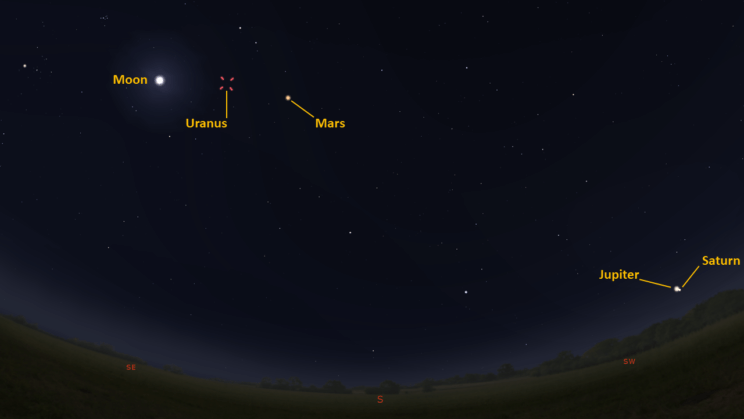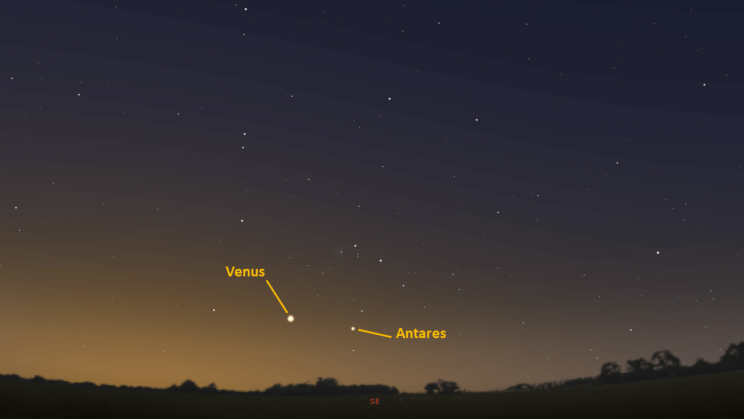This is the Saint Louis Science Center’s NIGHT SKY UPDATE for the week of Friday, December 25, 2020.
Information updated weekly or as needed.
Times given as local St. Louis time which is Central Standard Time (CST). For definitions of terminology used in the night sky update, click the highlighted text. If relying on times posted in Universal Time (UT), St. Louis is now -6 Hours from UT.
Public Telescope Viewings
Star parties at the Saint Louis Science Center have temporarily been canceled due to recommendations from the CDC regarding COVID-19. All public telescope events are canceled until further notice. As conditions change, we will reevaluate and update this article once public observing events resume.
Observing Highlight of the Week
The Great Conjunction has come and gone, but it is still worth tracking Jupiter and Saturn as we head into January. Jupiter and Saturn will become increasingly difficult to see as they head towards superior conjunction at the end of January. The little time we have to watch them before they head into the Sun’s glare is a great reminder that the planets are moving. The name planet means “wanderer” and if you watch Jupiter and Saturn over the next few weeks you will see Jupiter is quickly moving away from Saturn.
Watching this behavior of the planets was one of the keys to discovering the heliocentric nature of the solar system. Over the next few years, we can watch as Saturn and Jupiter get farther apart. They will also encounter other planets as they move along their paths around the Sun. A few close encounters to look forward to are the Jupiter and Saturn conjunctions with Mars in 2022. A great resource for finding information on planetary events like the Great Conjunction is in-the-sky.org.
The Sun and Moon

The Moon as seen from the International Space Station, on July 31, 2011.
Credit: NASA
Sunrise is at 7:17 a.m. on Friday, December 25 and sunset is at 4:46 p.m. providing us with less than 10 hours of daylight. Even after sunset, the light from the Sun will dimly illuminate our sky for about 1 hour and 30 minutes. This period is called twilight, which ends around 6:21 p.m. this week. For those with a sundial, local noon occurs around 12:02 p.m. this week.
Perihelion 2021
On January 2, 2021 at 7:50 a.m., the Earth will be its closest to the Sun for 2021. This point is called perihelion which happens during winter in the northern hemisphere. As Earth orbits the Sun it has a close and far point in its orbit which are called apsides. The far point is called aphelion. The difference in distance between these points is less than 4 million miles. At perihelion Earth is roughly 91 million miles from the Sun and at aphelion the distance is roughly 95 million miles. From year to year, the occurrence of Earth’s apsides can vary by 2 days.
Over time, the distance of these close and far points change due to gravitational effects induced by Jupiter and Saturn. Right now, Earth’s orbit is nearly circular but over a 100,000 year long cycle it becomes slightly more elliptical. This is a change in the eccentricity of Earth’s orbit. Currently Earth’s orbit is near its least elliptical. Earth’s changing orbital eccentricity along with its change in obliquity and its precession, are key factors in understanding ice ages. These changes are known as Milankovitch cycles which are named after a Serbian scientist named Milutin Milankovitch. If you would like to learn more about these long term cycles, NASA has an excellent article that can be found here.
| Day | Sunrise | Sunset |
|---|---|---|
| 2020-12-25 | 7:17 a.m. | 4:46 p.m. |
| 2020-12-26 | 7:18 a.m. | 4:46 p.m. |
| 2020-12-27 | 7:18 a.m. | 4:47 p.m. |
| 2020-12-28 | 7:18 a.m. | 4:48 p.m. |
| 2020-12-29 | 7:19 a.m. | 4:49 p.m. |
| 2020-12-30 | 7:19 a.m. | 4:49 p.m. |
| 2020-12-31 | 7:19 a.m. | 4:50 p.m. |
| 2020-01-01 | 7:19 a.m. | 4:50 p.m. |
| 2020-01-02 | 7:19 a.m. | 4:51 p.m. |
Moon
Moonrise for Friday, December 25 occurs at 1:55 p.m. and moonset will occur at 3:59 a.m. on the following day. On Friday, December 25 the Moon will exhibit a waxing gibbous phase with 81% of the lunar disk illuminated. Full moon occurs on December 29 at 9:28 p.m.
International Space Station (ISS) Observing

Visible passes of ISS from St. Louis for the week of December 25 occur during morning hours. The best pass this week occurs on the morning of January 3. Use the table below for information about this and other visible passes this week.
Catch ISS from St. Louis starting Friday, December 25
| Date | Starts | Max. altitude | Ends | |||||||
|---|---|---|---|---|---|---|---|---|---|---|
| Time | Alt. | Az. | Time | Alt. | Az. | Time | Alt. | Az. | ||
| 01 Jan | -1.4 | 06:34:48 | 10 | NNW | 06:36:47 | 15 | NNE | 06:38:46 | 10 | NE |
| 03 Jan | -2.1 | 06:35:33 | 10 | NNW | 06:38:28 | 26 | NNE | 06:41:21 | 10 | E |
Magnitude (Mag): The Measure of brightness for a celestial object. The lower the value is, the brighter the object will be.
Altitude (Alt): The angle of a celestial object measured upwards from the observer’s horizon.
Azimuth (Az): The direction of a celestial object, measured clockwise from an observer’s location with north being 0°, east being 90°, south being 180° and west being 270°.
For information about ISS flyovers and other visible satellites, visit www.heavens-above.com
Detailed information regarding all unmanned exploration of our universe, missions past, present, and planned, can be found at Jet Propulsion Laboratories:
The Visible Planets

Looking South, at 6:00 pm, December 25, 2020
Credit: Stellarium, EG

Looking Southeast, 6:30 am, December 26, 2020
Credit: Stellarium, EG
This week, four naked eye planets are visible. Jupiter and Saturn are found in the southwest once it is dark. Mars is found high in the south after sunset. Venus can be found in the eastern sky before sunrise.
Venus
Venus rises at 5:41 a.m. and will be easily seen by 6:30 a.m. Venus remains a morning object until March 26, 2021 when it reaches superior conjunction. Since Venus has passed greatest western elongation, it is exhibiting a gibbous phase.
Mars
Currently Mars appears as a -0.4-magnitude object that will be visible high in the south about 30 minutes after sunset. Mars sets by 1:46 a.m. We are still near enough to Mars that surface features are visible through telescopes. Earth is moving away from Mars which means Mars is getting fainter each night. The observing season for this apparition ends around March 10, 2021 and superior conjunction occurs on October 7, 2021.
Jupiter
Look for Jupiter in the south about 30 minutes after sunset. Jupiter will set at 6:46 p.m. Those with a telescope can enjoy views of Jupiter’s cloud features and the Great Red Spot when it is pointed towards Earth.
Saturn
Look for the ringed planet in the south about 30 minutes after sunset. Saturn sets at 6:44 p.m. For those with a telescope keep track of the orientation of Saturn’s rings. Since Saturn is tilted on its rotational axis, we cross the plane of Saturn’s ring every 13 to 15 years. We are headed towards another ring plane crossing on March 23, 2025. Over the next five years you will notice Saturn’s rings will gradually incline towards an edge on appearance.
Uranus
Uranus is not a planet we normally include in this section. Even at its dimmest, the giant planet does hover within naked eye visibility. That said, it is so close to the visible limit of the human eye it just is not reality for most of us to see Uranus without binoculars or a telescope. Uranus is just past opposition and as such, it is still easy to spot. You can find Uranus in the constellation Aries the Ram. The current magnitude for Uranus is 5.7. A finder chart for Uranus can be found here.
Visit the James S. McDonnell Planetarium for more information on what’s up!
Night Sky Update: December 25-January 02, 2020






